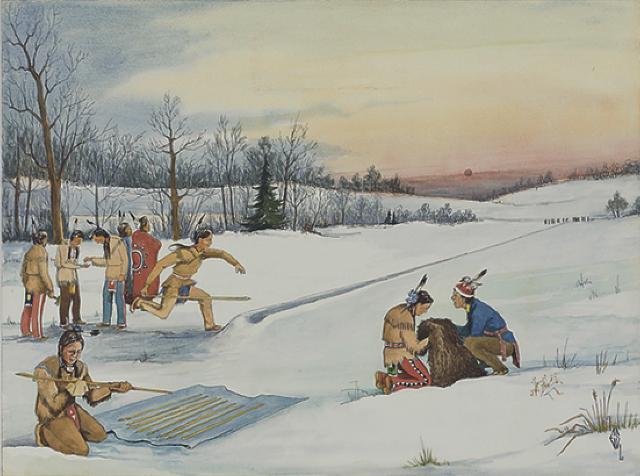 |
Canku Ota
|
 |
|
(Many Paths)
|
||
|
An Online Newsletter
Celebrating Native America
|
||
|
DECemBER 2020 - Volume
18 Number 12
|
||
|
|
||
|
The Winter Solstice
Begins A Season Of Storytelling And Ceremony
|
||
|
by Dennis Zotigh - Smithsonian
Magazine
|
||
In the Northern Hemisphere, December 21 will be the year’s day of least sunlight, when the sun takes its lowest, shortest path across the sky. North of the Arctic Circle, it will be the midpoint of the period of darkness, when even twilight doesn’t reach the horizon. As we did before the solar eclipse in August, this December we asked our Native friends to share traditions they’ve heard about the winter solstice. Their answers highlight winter as a time for storytelling. Ojibwe (Minnesota Chippewa Tribe): This description of winter in many Native communities was prepared by the Indian Land Tenure Foundation/Lessons of Our Land as background for teachers:
San Carlos Apache (Arizona): This reminds me when I was young. My grandfather would ask a really older man to come visit. We would eat dinner; they would visit, smoke. Then my grandpa would put a bundle at his feet. Soon he would start telling stories most of the night. Ho-Chunk Nation of Wisconsin: We have to wait for the Winter Moon, and there has to be snow on Mother Earth for those stories. Blackfoot (Calgary, Alberta): Blackfoots are the same with the snow and stories. Acoma Pueblo (New Mexico): The winter solstice marks our New Year in Acoma. We mark the time with ceremonies not privy to the public. It’s also the time of haamaaha, storytelling of the coyote, stories of heroes, stories of the animals, sharing of knowledge. My parents said that when you call haamaaha, people will arrive with piñon nuts gathered in the fall that are roasted and shared. Passamaquoddy (New England): In traditional calendars in the Northeast, the solstice is always marked. For my folks it’s a sign that the frost giants will be returning to the North. Assiniboine/Sioux (South Dakota): Waniyetu [winter]—time for gathering can'sa'sa [red willow bark] while the Thunder is gone. Syilx (Washington State & British Columbia): What I know is that it marks the point in time when our Winter Ceremonies can be held. My grandmother sometimes held her first ceremony of the winter at this powerful time. We have winter dance ceremonies; prayers for the new year to come, for the berries, roots, four-leggeds, and fish—the four Food Chiefs; prayers for our families and ourselves. There are songs, dancing, feasting, and a give-away. This is held during the evening and can go all night, depending on the number of sacred singers who come to share. The ceremonies are called winter dances. Or my grandfather also called them Chinook dances. In our territory to the south in Washington State around Nespelem, my grandfather told me of one dance ceremony lasting ten nights in a row!
Dennis W. Zotigh (Kiowa/San Juan Pueblo/Santee Dakota Indian) is a member of the Kiowa Gourd Clan and San Juan Pueblo Winter Clan and a descendant of Sitting Bear and No Retreat, both principal war chiefs of the Kiowas. Dennis works as a writer and cultural specialist at the Smithsonian National Museum of the American Indian in Washington, D.C.
Indian Land
Tenure Foundation Lessons
of Our Land |
||
|
|
||
|
|
||
| Canku Ota is a free Newsletter celebrating Native America, its traditions and accomplishments . We do not provide subscriber or visitor names to anyone. Some articles presented in Canku Ota may contain copyright material. We have received appropriate permissions for republishing any articles. Material appearing here is distributed without profit or monetary gain to those who have expressed an interest. This is in accordance with Title 17 U.S.C. Section 107. | ||
|
Canku Ota is a copyright ©
2000 - 2020 of Vicki Williams Barry and Paul Barry.
|
||
 |
 |
|
|
The "Canku
Ota - A Newsletter Celebrating Native America" web site and
its design is the
|
||
|
Copyright ©
1999 - 2020 of Paul C. Barry.
|
||
|
All Rights Reserved.
|
||
